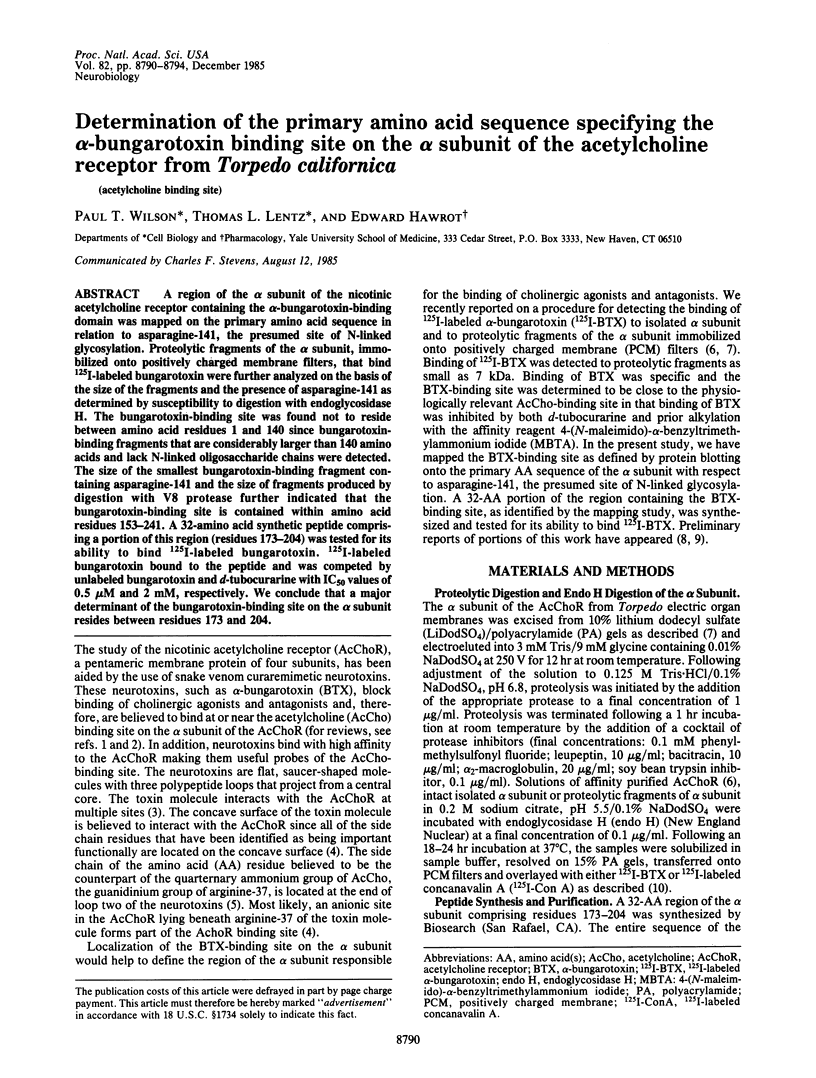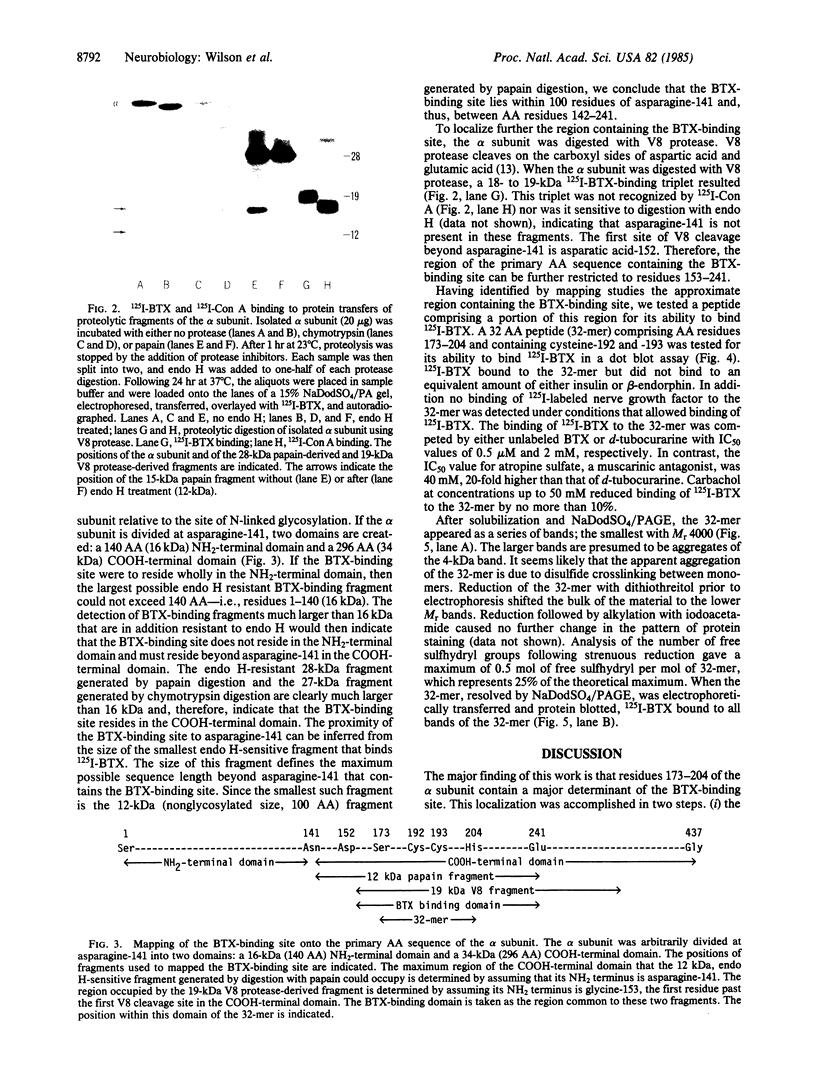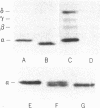Abstract
A region of the alpha subunit of the nicotinic acetylcholine receptor containing the alpha-bungarotoxin-binding domain was mapped on the primary amino acid sequence in relation to asparagine-141, the presumed site of N-linked glycosylation. Proteolytic fragments of the alpha subunit, immobilized onto positively charged membrane filters, that bind 125I-labeled bungarotoxin were further analyzed on the basis of the size of the fragments and the presence of asparagine-141 as determined by susceptibility to digestion with endoglycosidase H. The bungarotoxin-binding site was found not to reside between amino acid residues 1 and 140 since bungarotoxin-binding fragments that are considerably larger than 140 amino acids and lack N-linked oligosaccharide chains were detected. The size of the smallest bungarotoxin-binding fragment containing asparagine-141 and the size of fragments produced by digestion with V8 protease further indicated that the bungarotoxin-binding site is contained within amino acid residues 153-241. A 32-amino acid synthetic peptide comprising a portion of this region (residues 173-204) was tested for its ability to bind 125I-labeled bungarotoxin. 125I-labeled bungarotoxin bound to the peptide and was competed by unlabeled bungarotoxin and d-tubocurarine with IC50 values of 0.5 microM and 2 mM, respectively. We conclude that a major determinant of the bungarotoxin-binding site on the alpha subunit resides between residues 173 and 204.
Full text
PDF




Images in this article
Selected References
These references are in PubMed. This may not be the complete list of references from this article.
- Burley S. K., Petsko G. A. Aromatic-aromatic interaction: a mechanism of protein structure stabilization. Science. 1985 Jul 5;229(4708):23–28. doi: 10.1126/science.3892686. [DOI] [PubMed] [Google Scholar]
- Claude P., Hawrot E., Dunis D. A., Campenot R. B. Binding, internalization, and retrograde transport of 125I-nerve growth factor in cultured rat sympathetic neurons. J Neurosci. 1982 Apr;2(4):431–442. doi: 10.1523/JNEUROSCI.02-04-00431.1982. [DOI] [PMC free article] [PubMed] [Google Scholar]
- Conti-Tronconi B. M., Hunkapiller M. W., Raftery M. A. Molecular weight and structural nonequivalence of the mature alpha subunits of Torpedo californica acetylcholine receptor. Proc Natl Acad Sci U S A. 1984 May;81(9):2631–2634. doi: 10.1073/pnas.81.9.2631. [DOI] [PMC free article] [PubMed] [Google Scholar]
- Drapeau G. R., Boily Y., Houmard J. Purification and properties of an extracellular protease of Staphylococcus aureus. J Biol Chem. 1972 Oct 25;247(20):6720–6726. [PubMed] [Google Scholar]
- Fairclough R. H., Finer-Moore J., Love R. A., Kristofferson D., Desmeules P. J., Stroud R. M. Subunit organization and structure of an acetylcholine receptor. Cold Spring Harb Symp Quant Biol. 1983;48(Pt 1):9–20. doi: 10.1101/sqb.1983.048.01.004. [DOI] [PubMed] [Google Scholar]
- Gershoni J. M., Hawrot E., Lentz T. L. Binding of alpha-bungarotoxin to isolated alpha subunit of the acetylcholine receptor of Torpedo californica: quantitative analysis with protein blots. Proc Natl Acad Sci U S A. 1983 Aug;80(16):4973–4977. doi: 10.1073/pnas.80.16.4973. [DOI] [PMC free article] [PubMed] [Google Scholar]
- Gershoni J. M., Palade G. E. Electrophoretic transfer of proteins from sodium dodecyl sulfate-polyacrylamide gels to a positively charged membrane filter. Anal Biochem. 1982 Aug;124(2):396–405. doi: 10.1016/0003-2697(82)90056-2. [DOI] [PubMed] [Google Scholar]
- Gullick W. J., Tzartos S., Lindstrom J. Monoclonal antibodies as probes of acetylcholine receptor structure. 1. Peptide mapping. Biochemistry. 1981 Apr 14;20(8):2173–2180. doi: 10.1021/bi00511a016. [DOI] [PubMed] [Google Scholar]
- Habeeb A. F. A sensitive method for localization of disulfide containing peptides in column effluents. Anal Biochem. 1973 Nov;56(1):60–65. doi: 10.1016/0003-2697(73)90169-3. [DOI] [PubMed] [Google Scholar]
- Kao P. N., Dwork A. J., Kaldany R. R., Silver M. L., Wideman J., Stein S., Karlin A. Identification of the alpha subunit half-cystine specifically labeled by an affinity reagent for the acetylcholine receptor binding site. J Biol Chem. 1984 Oct 10;259(19):11662–11665. [PubMed] [Google Scholar]
- Lindstrom J., Tzartos S., Gullick W., Hochschwender S., Swanson L., Sargent P., Jacob M., Montal M. Use of monoclonal antibodies to study acetylcholine receptors from electric organs, muscle, and brain and the autoimmune response to receptor in myasthenia gravis. Cold Spring Harb Symp Quant Biol. 1983;48(Pt 1):89–99. doi: 10.1101/sqb.1983.048.01.012. [DOI] [PubMed] [Google Scholar]
- Martin B. M., Chibber B. A., Maelicke A. The sites of neurotoxicity in alpha-cobratoxin. J Biol Chem. 1983 Jul 25;258(14):8714–8722. [PubMed] [Google Scholar]
- McCormick D. J., Atassi M. Z. Localization and synthesis of the acetylcholine-binding site in the alpha-chain of the Torpedo californica acetylcholine receptor. Biochem J. 1984 Dec 15;224(3):995–1000. doi: 10.1042/bj2240995. [DOI] [PMC free article] [PubMed] [Google Scholar]
- Neumann D., Gershoni J. M., Fridkin M., Fuchs S. Antibodies to synthetic peptides as probes for the binding site on the alpha subunit of the acetylcholine receptor. Proc Natl Acad Sci U S A. 1985 May;82(10):3490–3493. doi: 10.1073/pnas.82.10.3490. [DOI] [PMC free article] [PubMed] [Google Scholar]
- Noda M., Furutani Y., Takahashi H., Toyosato M., Tanabe T., Shimizu S., Kikyotani S., Kayano T., Hirose T., Inayama S. Cloning and sequence analysis of calf cDNA and human genomic DNA encoding alpha-subunit precursor of muscle acetylcholine receptor. 1983 Oct 27-Nov 2Nature. 305(5937):818–823. doi: 10.1038/305818a0. [DOI] [PubMed] [Google Scholar]
- Noda M., Takahashi H., Tanabe T., Toyosato M., Kikyotani S., Furutani Y., Hirose T., Takashima H., Inayama S., Miyata T. Structural homology of Torpedo californica acetylcholine receptor subunits. Nature. 1983 Apr 7;302(5908):528–532. doi: 10.1038/302528a0. [DOI] [PubMed] [Google Scholar]
- Plümer R., Fels G., Maelicke A. Antibodies against preselected peptides to map functional sites on the acetylcholine receptor. FEBS Lett. 1984 Dec 10;178(2):204–208. doi: 10.1016/0014-5793(84)80601-8. [DOI] [PubMed] [Google Scholar]
- Tsernoglou D., Petsko G. A., Hudson R. A. Structure and function of snake venom curarimimetic neurotoxins. Mol Pharmacol. 1978 Jul;14(4):710–716. [PubMed] [Google Scholar]
- Wilson P. T., Gershoni J. M., Hawrot E., Lentz T. L. Binding of alpha-bungarotoxin to proteolytic fragments of the alpha subunit of Torpedo acetylcholine receptor analyzed by protein transfer on positively charged membrane filters. Proc Natl Acad Sci U S A. 1984 Apr;81(8):2553–2557. doi: 10.1073/pnas.81.8.2553. [DOI] [PMC free article] [PubMed] [Google Scholar]






